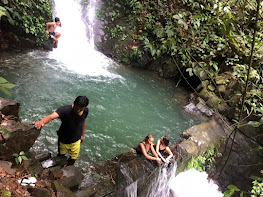
BUKIT LAWANG
Lost in the depths of Sumatra, Bukit Lawang is a small riverside
town built beside the rainforest of the vast Gunung Leuser National Park.
The island of Sumatra was once covered with jungle, but at the
turn of the twentieth century, the rise of the automobile meant that there was
a huge new demand for rubber, to make tires. The Dutch government and the
various Sultans of the region around Medan granted rights to cut almost all the
jungle around Medan, to plant rubber, which is a tree originally from the
Brazilian rainforest. Dozens of plantations were established across North
Sumatra, including the ‘Bukit Lawang’ plantation. At this time there was no
village in Bukit Lawang, although the nearby village of Timbang Lawang (around
4km), and the town of Bohorok (around 10km away) were already in existence.
There was also little concern for the wildlife in the rainforest, as wildlife
was often considered a nuisance, and a barrier to progress.
The conservation status of the orangutan became of international
concern in the 1960s, and in 1964 the Sepilok orangutan rehabilitation centre,
in Sabah, Malaysia, became the first to attempt to rehabilitate captive
orangutans. In 1971, the Ketambe orangutan centre was established in Aceh,
North Sumatra, not far as the crow flies (less than 20km across the Bukit
Barisan mountain range) from Bukit Lawang, but a long way and arduous by road.
In 1973, Regina Frey and Monica Boerner, two Swiss zoologists, established an
orangutan rehabilitation centre at Bukit Lawang. This they called the Bohorok
Orangutan Centre after the nearby town of Bohorok. Although illegal, orangutans
were widely held as pets in Indonesia, and the centre sought to reintroduce
them to the wild. It was supported by the WWF (World Wildlife Fund) and
Frankfurt Zoological Society. In 1975, they left (although Regina Frey is still
active today in Bukit Lawang) and the centre was taken over by Rosalind and
Conrad Aveling.
The practice of keeping orangutans as pets was very damaging to the wild
population as people sought only baby orangutans, who were cute and relatively
easy to handle in comparison to an adult orangutan, which is large and four
times stronger than an adult human. In doing so it was usual to kill the mother
of the baby, usually by shooting her, a process that often killed the baby as
well – it is estimated that five orangutans are killed for every one that is
successfully brought to market as a pet.
The centre was built a couple of kilometres from the nearest village in order
to minimise contact with humans – the orangutans were after all being trained
to live away from human contact. The ability to see orangutans in close
proximity brought first local and later international tourists to the village,
and soon a visitors centre was built, as more tourists arrived.
The following documentary, split in four parts, documents the work of the
Orangutan Rehabilitation Centre in about 1975-1976.
In 1976 the government agency PHPA built the first guesthouse, against the
wishes of the WWF, which was concerned about greater tourist numbers exposing
orangutans to human diseases. In 1980 the rehabilitation centre was taken over
by Indonesia, under the leadership of Dr. Suharto Djojosudharmo.
Tourism developed rapidly in the early 1990s, with accommodation going from
three guesthouses in 1989 to 32 in 1991. By 1994 the government recognised that
with increased development and tourist numbers Bukit Lawang no longer
functioned for rehabilitation given the problems of mass tourism and issues
such as guides feeding the released orangutans. The last rehabilitated
orangutans were received in Bukit Lawang in 2001. With the ending of
rehabilitation, Bukit Lawang has since functioned as a location to view
semi-wild orangutans, as part of a jungle trek (unofficial feeding sessions
ended in 2015).
For local tourists. who usually visit on weekends, particularly
Sundays, visiting the jungle is of lesser interest, and many prefer to relax in
the village, swimming or tubing in the river, eating in the simple restaurants
and related activities.
Foreign tourists are generally initially attracted to Bukit Lawang
by the possibility to view orangutans in their natural habitat, a different
experience from zoos, and the opportunity to take part in ‘jungle treks’. Many
however find that Bukit Lawang offers other attractions beyond the red apes and
stay for weeks or even years, enjoying the relaxed lifestyle of this
tourism-dependent village – enjoying a banana pancake by the river or smoking a
spliff while listening or joining local guide playing guitar and singing. While
such experiences can be had all over the Southeast Asian backpacker trail, many
visitors return to Bukit Lawang over and over again because things in Bukit
Lawang are just a little different.
Of course some tourists might prefer to visit ‘undiscovered’, more primitive
places, where genuine conservation works still takes place, but of course as
mentioned genuine orangutan rehabilitation is not consistent with mass tourism,
and while Bukit Lawang is arguably a tourist trap by Sumatran standards, a
Sumatran tourist trap is a very far cry from a Balinese or Thai tourist trap
(which of course themselves enjoy many happy visitors each year). If you are
looking for a few huts and no tourists, Bukit Lawang won’t be for you. But if
you would be bored by such a place, Bukit Lawang is a great place to learn a
bit more about orangutans and also enjoy a relaxing time by the river on the
edge of a national park.

















